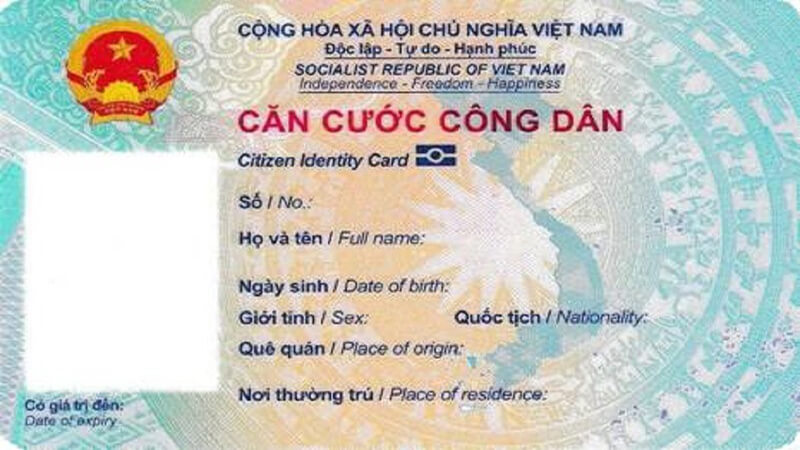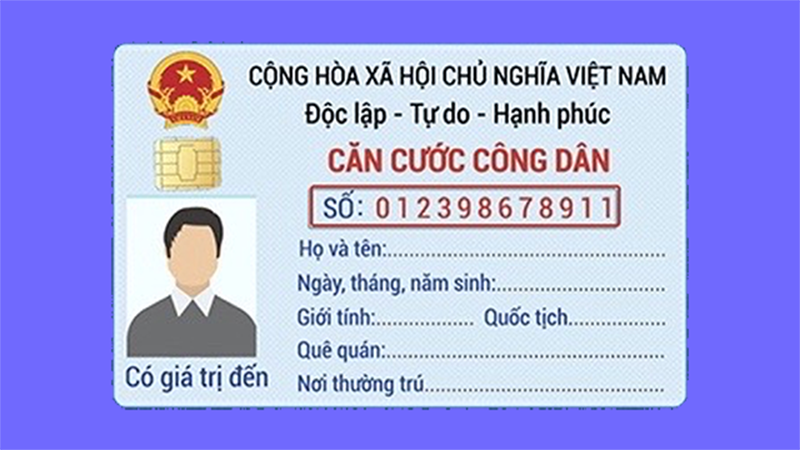The new personal document, the CCCD with a chip, is a significant upgrade that stores all your personal information. To learn about the procedures for obtaining this new CCCD and the meaning of the 12 numbers on the new ID card, read on.
1 Documents Required for First-Time Application of CCCD with a Chip
According to the Law on Citizen Identification, Circular No. 59/2021/TT-BCA, and Circular No. 60/2021/TT-BCA, for first-time applicants of the CCCD with a chip, if your citizen information is not in the National Database on Population or has changed, you need to bring one of the following legal documents as proof of the change to update and supplement your information in the application file: household registration book or temporary residence book, birth certificate.
For further reference:
2 Who Is Eligible for a First-Time CCCD with a Chip?

According to Clause 1, Article 19 of the 2014 Law on Citizen Identification, Vietnamese citizens aged 14 and above are eligible for a Citizen Identification Card. This card must be renewed when the citizen reaches the ages of 25, 40, and 60 (Article 21).
Additionally, individuals holding a 9-digit or 12-digit Identification Card or a bar-coded Citizen Identification Card can request to switch to the CCCD with a chip or wait until their current card expires.
3 What Is the Fee for a First-Time CCCD with a Chip?
From July 1, 2022, the fee for obtaining the CCCD with a chip is stipulated in Article 4 of Circular No. 59/2019/TT-BTC.
- For citizens switching from a 9-digit or 12-digit Identification Card to the CCCD: VND 30,000/CCCD.
- For those who need to replace their CCCD due to damage, changes in their first name, middle name, or last name; distinctive features; gender reassignment; hometown; incorrect information on the card; or other requests: VND 50,000/CCCD.
- For those who have lost their CCCD or have regained Vietnamese citizenship according to the Law on Vietnamese Nationality: VND 70,000/CCCD.
For further reference:

4 Procedures for First-Time Application of CCCD with a Chip
CCCD with a Chip Application Requirements
- Online application;
- Application at the police station
Receiving CCCD with a Chip Application Requests
When applying for the CCCD with a chip, you need to bring your household registration book and fill out the CCCD application form.
Upon arrival at the CCCD application site, present your household registration book. The officer will then check and compare your information in the CCCD application form with the information in the household registration book or the National Database on Population to verify your identity.
Photograph and Fingerprint Collection
If you meet the conditions and have completed the necessary procedures, the officer will take your photograph and collect your fingerprints and distinctive features to be printed on the CCCD information collection form and the CCCD as per regulations.
The officer will collect your fingerprints using a fingerprint collection machine. In cases where a finger is missing, deformed, or has a disability that prevents fingerprint collection, the officer will make a note in the corresponding finger position.
For further reference:
Receiving the Results
You will receive a receipt for your CCCD. You can pick up your CCCD at the police station indicated on the receipt or have it delivered via postal services (postal fees apply).
5 Procedures for Switching from Old ID Cards to CCCD with a Chip
* For 9-digit ID Cards
– If the 9-digit ID card is still clear (photo, ID number, and text), the officer will cut off the top right corner of the front of the ID card, with each side of the square corner being 2cm long. They will then make a note in the file and return the cut ID card to the applicant.
If requested by the citizen, the officer will issue a confirmation of the 9-digit ID number.
– If the 9-digit ID card is damaged, flaking, or unclear (photo, ID number, and text), it will be collected and destroyed, and a note will be made in the file. The officer will then issue a confirmation of the 9-digit ID number to the citizen.
– If the 9-digit ID card is lost when applying for the CCCD, the citizen can request a confirmation of the lost 9-digit ID number from the CCCD application receiving agency.

* For 12-digit ID Cards
The officer will cut off the top right corner of the front of the 12-digit ID card, with each side of the right-angled corner being 1.5cm long. They will then make a note in the file and return the cut ID card to the applicant.
If the citizen meets the conditions and has completed the necessary procedures, their photograph will be taken, and fingerprints and distinctive features will be collected to be printed on the CCCD information collection form and the CCCD as per regulations.
The officer will collect the citizen’s fingerprints using a fingerprint collection machine. In cases where a finger is missing, deformed, or has a disability that prevents fingerprint collection, the officer will make a note in the corresponding finger position.
Procedures for Switching from Bar-coded CCCD
The process of switching from a bar-coded CCCD to a CCCD with a chip is similar to switching from a 9-digit or 12-digit ID card to a CCCD with a chip. However, when switching from a bar-coded CCCD to a CCCD with a chip, the old bar-coded CCCD will be collected (Clause 3, Article 24 of the CCCD Law).
Currently, the Ministry of Public Security has proposed switching to the CCCD with a chip in the draft Circular detailing Decree 137/2015/ND-CP and the Law on Citizen Identification (second time). However, this draft has not been approved yet. LuatVietnam will update readers as soon as this draft is officially approved and takes effect.
If you have any further questions about the CCCD with a chip or any other legal issues, please contact: 1900.6192 for assistance.
For further reference:

According to Article 7 of Circular No. 07/2016/TT-BCA, the meaning of each digit is as follows:
– The first three digits represent the code of the province or centrally-run city, or the country code where the citizen was born,
– The next digit represents the citizen’s gender code
– The following two digits represent the citizen’s birth year;
– The last six digits are random numbers.
6 Frequently Asked Questions about First-Time CCCD with a Chip Application
Where Can I Apply for a First-Time CCCD with a Chip?
You can apply for a first-time CCCD with a chip at:
- The CCCD Management Agency of the district-level Public Security unit and equivalent administrative units receives applications for CCCD issuance, renewal, or re-issuance for citizens with permanent residence registration in that locality.
- The CCCD Management Agency of the provincial-level Public Security unit receives applications for CCCD issuance, renewal, or re-issuance for citizens with permanent residence registration within the province or centrally-run city and for citizens with permanent residence registration in other provinces or centrally-run cities in cases specified in Points a and b, Clause 1, Article 23 of the Law on Citizen Identification.
- The CCCD Management Agency of the Ministry of Public Security receives applications for CCCD renewal upon citizen request and in other special cases decided by the head of the CCCD Management Agency of the Ministry of Public Security.
For further reference:
What Are the Procedures for First-Time CCCD with a Chip Application for Vietnamese Citizens Living Abroad?
According to Lawyer Nguyen Ngo Quang Nhat’s advice in the Tuoi Tre newspaper, if you are living abroad, you need to follow these steps:
- Return to Vietnam and report your residence information to the residence registration agency at your current place of residence in Vietnam.
- Register for permanent or temporary residence as soon as you meet the conditions specified in the Law on Residence.
- Go to the competent police agency to request the issuance of a citizen identification card or make a request through the National Public Service Portal, the Public Security Ministry’s Public Service Portal.
How to Apply for a First-Time CCCD with a Chip Online?
We hope you found this information helpful. If you’re still unsure about how to obtain the CCCD with a chip, follow these steps and give it a try!
The Essential Documents for Obtaining a CCCD Chip-Enabled Card
“The buzz around CCCD chip implants is undeniable, and it’s time to unravel the mystery. As you embark on this futuristic journey, let’s ensure you have all the essential paperwork in order. Consider this your go-to guide, crafted with meticulous attention to detail, to navigate the CCCD chip implantation process with ease. Get ready to enhance your understanding and embark on this exciting path with confidence!”
The Ultimate Guide to Sponsoring Your Spouse’s Visa to Germany: A Step-by-Step Process
Introducing the ultimate guide to spouse visa sponsorship in Germany. Are you ready to embark on a journey of a lifetime with your significant other? We are here to ensure a smooth and hassle-free process. Discover the essential steps and requirements to bring your spouse to Germany, and join us as we explore this exciting path together.






































